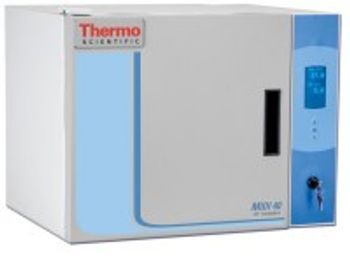
CO2 incubators are mainly used for cell culture and provide control over factors such as temperature, CO2 for maintaining proper pH levels, and humidity, all of which affect cell growth. CO2 incubators are typically heated to 37°C and maintain 95% relative humidity and a CO2 level of 5 percent. This guide will introduce the three main types of C02 Incubators available. Read about each one and then proceed to the appropriate sub categories where you will find an unbiased list of all the models from all manufacturers that may suit your needs.
 Water Jacketed
Water Jacketed
CO2 Incubator temperature control consists of a separate enclosure around 5 sides of the incubator-- everywhere but the door--that is filled with heated water. The heated water is circulated inside the enclosure, often by fans but also by natural heat convection, to maintain a consistent temperature inside the incubator. One of the benefi ts of choosing a water-jacketed model is that the water within the jacket not only provides heat, but also acts as an insulator. This means that during frequent door openings or power outages, samples inside the CO2 Incubator will remain protected at the set temperature. The water jacket also provides consistent temperate over the surface area of the inner walls.
View all Water Jacketed CO2 Incubators
Air Jacketed
CO2 Incubators are heated using a separate isolated air jacket on the 5 walls of the incubator. Some have a heated air chamber on the door as well, creating a full 6-sided heat source. The air inside the jacket is often circulated using a series of small fans. Such a design eliminates the need for fans inside the actual incubator chamber and prevents samples from drying out. One advantage of an air jacketed system is that if the temperature drops below the set point, the unit can ramp back up to its set temperature quickly. Air jacketed incubators do not require much in the way of maintenance, as there are no water reservoirs to fi ll. Operationally, they are almost “set it and forget it.” Air jacketed systems are also lighter in weight than other systems, making them easier to move around the lab if need be. Some manufacturers use a patented technology that is a combination of direct heat and air jacketed, they are also included in this section.
View all Air Jacketed CO2 Incubators
Direct Heat
Since there is no need for a jacket, direct heat incubators offer greater internal capacity in a smaller footprint than an air or water-jacketed system. Another advantage is that they are often priced at a lower price point than a jacketed system. Heating comes from all six sides of the incubator, including the door, which allows for convection circulation and temperature uniformity without the need for fans.
View all Direct Heat CO2 Incubators
